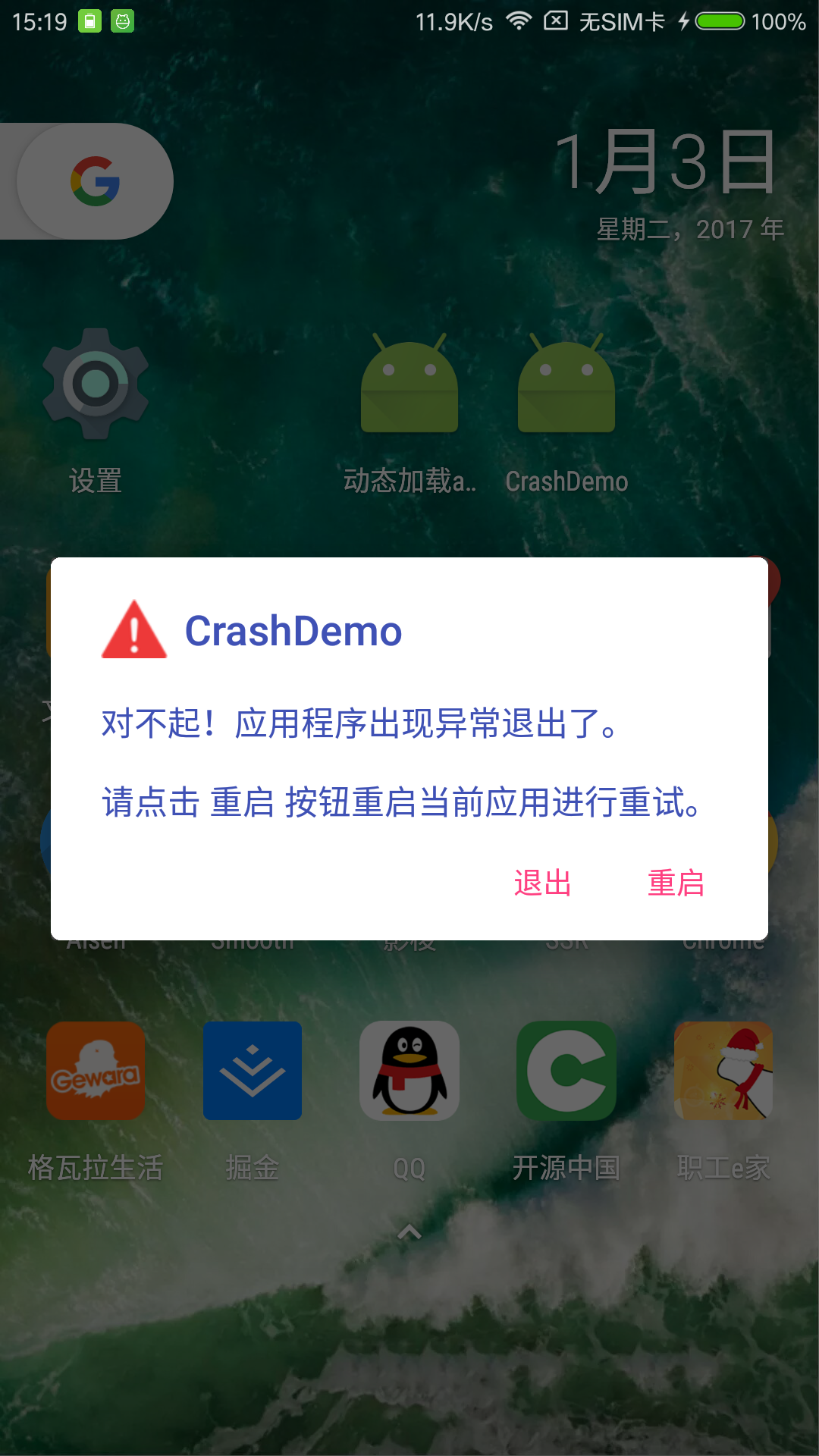由于我们写的代码难免会出现一些bug,以及由于测试环境和生产环境差异导致出现的一些异常,在测试过程中没有发现,而在app上线之后会偶然出现的一些bug,以至于app在使用过程中出现ANR,这是个令人蛋疼的现象,app卡死、出现黑屏等,总之当app出现异常时的用户体验不友好,我们开发者需要去捕获这些异常,收集这些异常信息,并且上传到服务器,利于开发人员去解决这些问题,同时,我们还需要给用户一个友好的交互体验。
我也查找了许多捕获崩溃异常的文章来看,但大多都千篇一律,只说了怎么捕获异常,处理异常,并没有对捕获异常后的界面交互做出很好的处理,系统出现ANR时会先卡一段时间(这个时间还有点长)然后弹出一个系统默认的对话框,但是我现在需要的是当出现异常情况时,立马弹出对话框,并且对话框我想自定义界面。
最终实现的效果如图:

首先需要自定义Application,并且在AndroidManifest.xml中进行配置
AndroidManifest.xml.png
还需要自定义一个应用异常捕获类AppUncaughtExceptionHandler,它必须得实现Thread.UncaughtExceptionHandler接口,另外还需要重写uncaughtException方法,去按我们自己的方式来处理异常
在Application中我们只需要初始化自定义的异常捕获类即可:
@Override public void onCreate() {
super.onCreate();
mInstance = this;
// 初始化文件目录
SdcardConfig.getInstance().initSdcard();
// 捕捉异常
AppUncaughtExceptionHandler crashHandler = AppUncaughtExceptionHandler.getInstance();
crashHandler.init(getApplicationContext());
}
其中文件目录是异常信息保存在sd卡中的目录,还有我们是整个app中全局捕获异常,所以我们自定义的捕获类是单例。
/**
* 初始化捕获类
*
* @param context
*/
public void init(Context context) {
applicationContext = context.getApplicationContext();
crashing = false;
//获取系统默认的UncaughtException处理器
mDefaultHandler = Thread.getDefaultUncaughtExceptionHandler();
//设置该CrashHandler为程序的默认处理器
Thread.setDefaultUncaughtExceptionHandler(this);
}
完成以上过程后,接着需要重写uncaughtException方法:
@Override
public void uncaughtException(Thread thread, Throwable ex) {
if (crashing) {
return;
}
crashing = true;
// 打印异常信息
ex.printStackTrace();
// 我们没有处理异常 并且默认异常处理不为空 则交给系统处理
if (!handlelException(ex) && mDefaultHandler != null) {
// 系统处理
mDefaultHandler.uncaughtException(thread, ex);
}
byebye();
}
private void byebye() {
android.os.Process.killProcess(android.os.Process.myPid());
System.exit(0);
}
既然是我们自己处理异常,所以会先执行handlelException(ex)方法:
private boolean handlelException(Throwable ex) {
if (ex == null) {
return false;
}
try {
// 异常信息
String crashReport = getCrashReport(ex);
// TODO: 上传日志到服务器
// 保存到sd卡
saveExceptionToSdcard(crashReport);
// 提示对话框
showPatchDialog();
} catch (Exception e) {
return false;
}
return true;
}
获取的异常信息包括系统信息,app版本信息,以及手机制造商信息等:
/**
* 获取异常信息
* @param ex
* @return
*/
private String getCrashReport(Throwable ex) {
StringBuffer exceptionStr = new StringBuffer();
PackageInfo pinfo = CrashApplication.getInstance().getLocalPackageInfo();
if (pinfo != null) {
if (ex != null) {
//app版本信息
exceptionStr.append("App Version:" + pinfo.versionName);
exceptionStr.append("_" + pinfo.versionCode + "\n");
//手机系统信息
exceptionStr.append("OS Version:" + Build.VERSION.RELEASE);
exceptionStr.append("_");
exceptionStr.append(Build.VERSION.SDK_INT + "\n");
//手机制造商
exceptionStr.append("Vendor: " + Build.MANUFACTURER+ "\n");
//手机型号
exceptionStr.append("Model: " + Build.MODEL+ "\n");
String errorStr = ex.getLocalizedMessage();
if (TextUtils.isEmpty(errorStr)) {
errorStr = ex.getMessage();
}
if (TextUtils.isEmpty(errorStr)) {
errorStr = ex.toString();
}
exceptionStr.append("Exception: " + errorStr + "\n");
StackTraceElement[] elements = ex.getStackTrace();
if (elements != null) {
for (int i = 0; i < elements.length; i++) {
exceptionStr.append(elements[i].toString() + "\n");
}
}
} else {
exceptionStr.append("no exception. Throwable is null\n");
}
return exceptionStr.toString();
} else {
return "";
}
}
将异常信息保存到sd卡这个我觉得可选吧,但是上传到服务端还是很有必要的:
/**
* 保存错误报告到sd卡
* @param errorReason
*/
private void saveExceptionToSdcard(String errorReason) {
try {
Log.e("CrashDemo", "AppUncaughtExceptionHandler执行了一次");
String time = mFormatter.format(new Date());
String fileName = "Crash-" + time + ".log";
if (SdcardConfig.getInstance().hasSDCard()) {
String path = SdcardConfig.LOG_FOLDER;
File dir = new File(path);
if (!dir.exists()) {
dir.mkdirs();
}
FileOutputStream fos = new FileOutputStream(path + fileName);
fos.write(errorReason.getBytes());
fos.close();
}
} catch (Exception e) {
Log.e("CrashDemo", "an error occured while writing file..." + e.getMessage());
}
}
保存在sd卡中的异常文件格式:
异常信息
至于上传到服务器,就比较灵活了,可以将整个文件上传,或者上传异常信息的字符串,可以和后端开发人员配合。
因为捕获异常后我要马上关闭掉app即上面的byebye方法,是将app整个进程杀死,如果接着要显示提示对话框,则需要在新的任务栈中打开activity:
public static Intent newIntent(Context context, String title, String ultimateMessage) {
Intent intent = new Intent();
intent.setClass(context, PatchDialogActivity.class);
intent.addFlags(Intent.FLAG_ACTIVITY_NEW_TASK);
intent.putExtra(EXTRA_TITLE, title);
intent.putExtra(EXTRA_ULTIMATE_MESSAGE, ultimateMessage);
return intent;
}
对话框中给出了重启操作的选项,重启过程的实现:
private void restart() {
Intent intent = getBaseContext().getPackageManager().getLaunchIntentForPackage(getBaseContext().getPackageName());
intent.addFlags(Intent.FLAG_ACTIVITY_CLEAR_TOP);
startActivity(intent);
super.onDestroy();
}





















 1万+
1万+











 被折叠的 条评论
为什么被折叠?
被折叠的 条评论
为什么被折叠?








